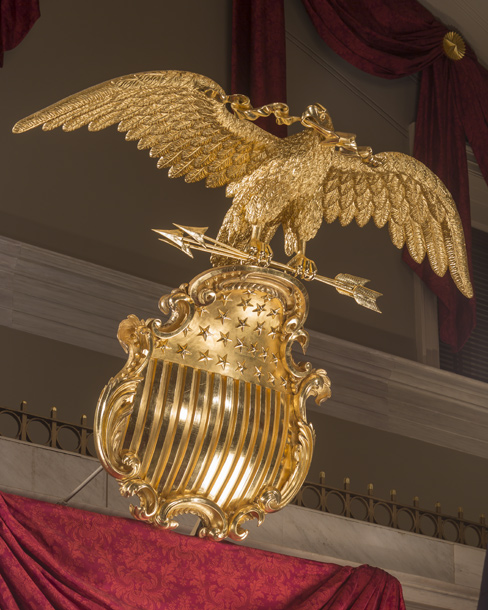
| Title | Eagle and Shield |
| Artist/Maker | Unidentified |
| Date | 1838 ca. |
| Medium | Wood, gilded |
| Dimensions | h. 53.5 x w. 72 x d. 23 in. (h. 135.9 x w. 182.9 x d. 58.4 cm) |
| Credit Line | U.S. Senate Collection |
| Accession Number | 25.00003.000 |
It is difficult to document the origin of the Senate’s gilded wood Eagle and Shield, which currently adorns the dais in the Old Senate Chamber. An 1809 plan for the room shows that architect Benjamin Henry Latrobe intended to hang an eagle crest and elaborate canopy over the vice president’s desk. His drawing also includes an oval cartouche or escutcheon of unspecified design on the eagle’s breast. However, Latrobe’s bird, with drooping wings, lacks the majesty and drama of the soaring eagle that exists today in the Old Senate Chamber. It is unclear whether his design ever became reality–-any evidence would have been destroyed when British troops burned the Capitol in 1814.
Further, records of the art in the Old Senate Chamber are notably scarce. The first reliable evidence of an eagle and shield located in this room appears in an 1838 article in the Daily National Intelligencer. It describes a “rich burnished shield, with an outer margin in the old French style, surmounted by an eagle of the size of life” hanging above the vice president’s dais in the room. [1] From this report it appears that the shield we know today existed from at least 1838, although the official records remain unclear on the matter. In 1846, Senate records indicate payment for “taking down curtains and drapery & irons for Eagle & shield.” The eagle and shield also appear in two mid-19th-century engravings: Thomas Doney’s United States Senate Chamber, published in 1846, and Robert Whitechurch’s The United States Senate, A.D. 1850, dated 1855. In addition, Senate records note that in 1847 a John Wagner was paid $10 for “carving & gilding 1 scroll for eagle,” although the Whitechurch engraving shows no such ribbon in the eagle’s beak.
After the Senate left the room and moved into its new Chamber in 1859, the Supreme Court of the United States used the space. Photographs from this period show that the shield was placed in the outer vestibule, over the door to the Chamber, while the eagle remained in the room. The ornate canopy that hung over the vice president’s desk was removed, and the eagle, now perched on a ribbon-draped horizontal bar, was affixed to the gallery balustrade above the chief justice’s desk. The Court occupied the room until 1935, when it moved to its new building across the street from the Capitol. For several more decades the Eagle and Shield remained in the same locations they occupied during the Court years–-the eagle inside the room on the gallery balustrade, and the shield outside over the Chamber’s door. In 1976 the two pieces were reunited inside the room for the restoration of the Old Senate Chamber.
Numerous artistic renderings of eagles are found in the United States Capitol, but the Eagle and Shield in the Old Senate Chamber has become the enduring symbol of the Senate. In 1838 Daniel Webster immortalized the Senate’s eagle as an icon of American patriotism when delivering one of the impassioned speeches for which he was famous. From the floor of the Senate, with the gilded eagle gazing down on him from above the vice president’s dais, he proclaimed, “We have made these struggles here, in the national councils, with the old flag, the true American flag, the Eagle, and the Stars and Stripes, waving over the chamber in which we sit.” [2]
1. ”The Capitol,” Daily National Intelligencer, 3 December 1838.
2. Congressional Globe (12 March 1838) 25th Cong., 2d sess.: 641.